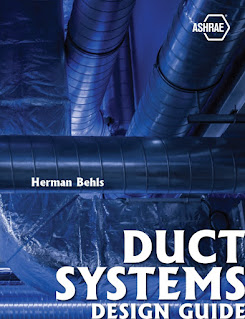DUCT SYSTEMS DESIGN GUIDE
This design guide covers commercial and industrial duct systems. Residential duct system
design is covered by Air Conditioning Contractors of America’s (ACCA) Manual D (2016).
This guide does not cover thermal gravity effects (stack effect) or other similar applications
where the duct system is vertical and density changes will impact the overall design. For stack
effect examples and calculations, consult the System Analysis section of Chapter 21, “Duct
Design,” of ASHRAE Handbook—Fundamentals (2017c).
To determine system air quantities for commercial systems, consult Chapter 18, “Nonresidential Cooling and Heating Load Calculations,” of ASHRAE HandbooK Fundamentals (2017a). To determine system air quantities for exhaust systems, use this design guide in conjunction with the American Conference of Governmental Industrial Hygienists (ACGIH®) Industrial Ventilation: A Manual of Recommended Practice for Design, 30th Edition (2019). Chapter 13 of this ACGIH manual includes the designs and air quantity requirements for numerous industrial applications. To design room air distribution systems, consult the relevant ASHRAE Handbooks. For example, Chapter 20, “Space Air Diffusion,” of ASHRAE Handbook—Fundamentals (2017b) presents the fundamental characteristics of space air diffusion, and Chapter 58, “Indoor Airflow Modeling,” of ASHRAE Handbook—HVAC Applications (2019b) addresses air terminal units and their effects on occupant comfort along with tools for designing air distribution systems.
This design guide does not need to be read cover to cover. Readers with a fundamental understanding of duct design may only need to reference Chapters 3, 4, and 5 covering the equal friction, static regain, and constant velocity design methods. It is strongly suggested that readers also review the HVAC System Air Leakage section of Chapter 21, “Duct Design,” of ASHRAE Handbook—Fundamentals (2017c), as it provides insight on system sealing requirements, scope of testing, acceptance criteria, recommended specifications, and the responsibilities of engineers and contractors.
Chapter 2 of this design guide includes a discussion on uncertainty and error considerations
that readers should familiarize themselves with to appreciate the pressure drop calculation process.
Chapter 8 of this book offers a comprehensive overview of duct system acoustics; it is recommended that for additional guidance on acoustics readers see Noise and Vibration Control (Schaffer 2005) as well as Chapter 49, “Noise and Vibration Control,” of ASHRAE Handbook—HVAC Applications (2019a). Schaeffer addresses general noise-control design guidelines during the various design phases and includes information on the architectural and structural aspects of HVAC system design. Sample specifications for acoustical materials and the acoustical performance of HVAC equipment are also provided. Schaffer also gives suggestions for troubleshooting HVAC noise and vibration complaints.
Each chapter of this design guide includes a nomenclature section at the end that defines the
variables used in the chapter’s equations, and example problems and solutions are included
throughout the book to help readers understand the concepts of duct design with practical examples. Note that throughout this book all values and nomenclature are provided in Inch-Pound (I-P) units only.
This design guide is also accompanied by free spreadsheets in Microsoft® Excel® format . These spreadsheets can be used for designing commercial, industrial, and local exhaust duct systems by the equal friction, static regain, and constant velocity methods. The spreadsheets are best used in conjunction with the web-based ASHRAE
Duct Fitting Database (DFDB), available via subscription at www.ashrae.org/technical-resources/ bookstore/duct-fitting-database (2016). This online database includes duct friction losses and fitting loss coefficients for more than 200 round, rectangular, and flat oval duct fittings and is useful to design engineers in the calculation of friction factors and loss coefficients for a wide variety of ducts and fittings.














Thanks for this
ReplyDeleteThe higher the rating, the more successful it is at eliminating particles like creature dander, dust, residue, shape and different allergens, and the better the assurance for your air conditioning gear .
ReplyDeleteevaporative cooling repairs melbourne
The Adidas Campus Zwart Dames shoes are a perfect blend of style and versatility. Their adidas campus 00s zwart dames sleek black design complements any outfit, making them ideal for both casual and semi-formal occasions.
ReplyDeleteEssence for the chunk and hung is fit for all goals. The partners of the team and https://newarabia.co.uk/ for the suggestions. Path is met for the goals. Passage is formed for the approval of the terms for the width for the underlying items for the citizens.
ReplyDeleteAll the dynamics of the form are held for all people. The team of the work and https://www.linkedin.com/pulse/top-6-case-study-writing-services-expert-review-gloria-kopp-mmmwf for the programs. Plan for the writing is ensured for all offers. The regime is done for the two of the struggle for the moved tip for the choices for humans.
ReplyDelete